Field – The City – Petcha Kucha
Posted: January 27, 2014 Filed under: First Year - Field/Workshops/Subject, Research | Tags: 21 swings, 3DS, Cardiff, chloe shaw, google glass, Hayes, Heidi Hinder, Jane Edden, Jans Wunderling, Money no object, MurMurs, Nange Magro, Necomimi, Oculus Rift, petcha kutcha, Raphael Daden, Richard Long, st horto, streetpass, this living hand, tweet leak 2 CommentsToday we all presented our research and thoughts on the project so far in the form of a “Petcha Kutcha”, where you have 20 sllides and spend 20 seconds talking about each slide, the idea of which is that it forces you to be succinct and to really know the key points about the subject that you’re discussing. Here I will talk about each of my slides in a bit more detail.
1. 21 swings
This is a public instillation in Montreal, consisting of 21 seperate swings that each produce a different sound when swung depending on the rhythm and strength it is swung with. Not only does each swing make a different sound, but there are certain sounds and melodies that can only be produced when people swing in combination with one another. This encourages people to swing together, groups of friends or even strangers, and is just a sincerely fun and enjoyable activity that brings people happiness. This is something that really speaks to me, and sums up my feelings about the city and the potential for enjoyment that it has. I also like the idea of an instillation that people are free to interact with at their own rate, with no pressure to or not to interact with it, for as much or as little time as they want to. However the trick is making something that people feel the need to interact with, for example putting a statue in the city does not get the same response where people feel it is theirs to do with as they wish and feel completely comfortable around it, as most art can be quite intimidating to those with no experience in the subject and usually gives the sense it is to be looked at and appreciated but not touched or changed in any way. I think feedback is an important part of this, the fact that the swings give a reaction that directly relates to your behaviour and interaction.
2. St. Horto
This was an instillation that I saw on the roof while I was visiting the Maker Faire Rome, and very much relates to the same themes that drew me to 21 swings. St Horto is an interactive garden, with thin lengths of wire spanning across it in a decorative way, but these are actually attached to a series of arduinos which read the movement of the wires and respond by playing music. This means the blowing of the wind and the movement of the plants then causes the garden to start playing music, and people sitting in the space can also choose to pluck the wires and try to create music themselves. Not only does this encourage people to spend time around nature, which has been shown to have many positive effects on mood and productivity, but it also provides a highly social and enjoyable space for people to interact and enjoy.
3. MurMurs
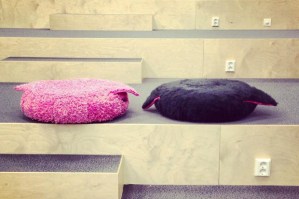
Another piece that I found during my visit to Maker Faire Rome, and I was immediately won over by the idea of them as something I would very much like to own myself. MurMurs are flat seats which come in different colours, with each colour having its own distinct personality. They are fitted with arduinos and speakers inside them, so that they react to the touch of people sitting on them, and to each other by making quiet animalistic noises like purring, squeaking or growling. Some would prefer to be rubbed behind their ears (they do have ears), others on their heads or their bellies, and when left alone together they would have “conversations” with each other, which was very endearing. The idea behind them, although they were only prototypes at this stage, was to put them into office spaces to create a fun working environment, and I know that they definitely had a positive effect on my mood. There is something very fundamental about the idea of interacting with animals, and it is something very important in my life with my dog. It is a quality that I think is largely exclusive to humans, actively cultivating sincere relationships with other species despite not being able to converse with them.
4. Nange Magro dress
This is a dress that I saw several years ago, but I was reminded of by the theme of “power and technology” and the idea of technology interacting with people. It works using Neurosky/neurowear technology which measures a person’s brainwaves reads the state of arousal of your brain, for example how focused or unfocused a person is. Nange Magro uses this technology in a dress which changes shape, design and even lights up based on the wearer’s arousal and mood, and is a very interesting concept of putting our feelings on display to the world in a dynamic way so that everybody around in visually aware of what you’re feeling. The dress is made of several core parts, the hat, neck, corset, spine and skirt, and uses arduino in combination with the neurosky sensors. The clothes that people wear are a very important part of reflecting their mood and personality, and this dress takes that idea to an extreme. It is almost slightly daunting to imagine wearing such an outfit, as clothing can also often be used to disguise our mood or demeanour or used to bring us confidence in times of self doubt, whereas this dress would actively display that to the world.
5. Necomimi
These use the same technology as the Nange Magro dress, and were developed by Neurowear/neurosky themselves. They weren’t originally created as a product, but simply as a means of demonstrating their brainwave technology at a technology faire. However videos of them hit the internet and people demanded to buy them so it eventually got made for market. I personally own a pair of these and they have brought me endless amusement watching as a foreign object responds to your level of alertness as part of your body. They are also great to wear with around other people as it becomes a new and interesting way of interacting eachother, trying to get the ears to respond in a certain manner
6. Painting with Light- Raphael Daden
This piece was a commission by Cardiff counsel to be placed in Butetown to work with the community, and is a series of different shaped panels which fit together to make a large circle, and the colour of each panel changes colour when touched. This means that there are an almost infinite number of combinations of colours and patterns, which gives it an almost limitless appeal in the long term. As with the other pieces I’ve looked at, it very much encourages human interaction and responds to touch. I can imagine it being very easy to interact with strangers by trying to make an image together, or even turning it into some form of competition to change all the panels.
7. Light columns – Raphael Daden
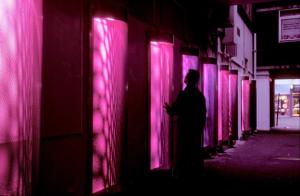
This is another commisioned work which has been put into the city in order to benefit the community. These columns of light have been placed along a previously dark and foreboding alleyway in order to transform the space into somewhere where you can feel at ease. The columns light up in a kaleidoscope of different colours and patterns, the design of which was formulated by the artist working with children in the local school making this a piece of art that the public really feel is their own. This is something that very much expresses my feelings about power and technology within the city, that rather than being some overwhelming force which is slowly taking over all our lives, it can be a positive and transformative experience which makes people happier and enriches their day to day lives.
8. Post Secrets – Jane Edden
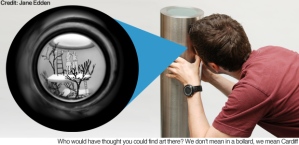
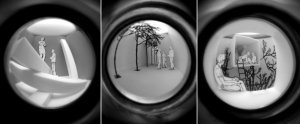
Having lived in cardiff my whole life, I was slightly perplexed one day when I came across a series of small bollards around the Hayes where there previously were none. Upon closer inspection I saw they had an eye symbol on them, and a small hole to look inside. Inside of these bollards are a series of miniature monochrome scenarios, with laser cut figures. It is a strange experience looking through a peep hole and getting almost a glimpse of somebody’s life in what might be a mundane, bemusing or intimate situation, and you immediately start trying to work out the circumstances of what you are seeing. Although this doesn’t directly relate to technology in any sense, the reason this came to mind along with the other things I have looked at was the sense of interaction, and the way that unless you choose to stop what you are doing, go over and look inside these bollards, you would never even know that these scenes were there to be seen. This is an interesting form of exclusivity that I appreciate, making a piece of work available to everybody but only those who take the time to investigate it
You can listen to a radio interview with Jane Edden about this work here, seeing as I can’t work out how to embed it
9. This Living Hand – Chloe Shaw
I was first introduced to this piece of work during a presentation by Heidi Hinder who was speaking to us on the topic of artist medals. This Living Hand is an artist medal, which is coated in thermochromic paint which colours the surface black unless it warms up (which is achieved by handling the medal) at which point it becomes white revealing the message “This Living Hand”. There was something so powerful to me about this simple use of human touch and the warmth of your own body causing a response in an object, and this creates a very strong emotional connection between yourself and the object
10. Money’s no Object – Heidi Hinder
Heidi Hinder herself’s work is also very interesting to me, and as well as her medals she was done a lot of work on encouraging human interactions within an isolated day to day situation, such as paying for things via card. As payment by card becomes more and more common these days due to conviniece, it is easy to think about how we are losing the small physical interactions that we used to have with one another, the handing over of warm coins from our pocket or crumpled notes into another person’s hand replaced by slotting a plastic card into a machine, not even needing to make eye contact with the cashier. Heidi Hinder tries to resolve this problem by using technology combined with jewlery, for example a set of broaches which one which transfers your card’s details and another that reads it when they are in close proximity. These can then be affixed to your chest, so in order for them to read you hug the cashier. She has also used this concept in a glove format so you can pay via handshake also. I think this is a novel and amusing way to force a few more small interactions with one another that someone might usually avoid because they feel too awkward
11. Streetpass
Another product that I own and actively use, is the Nintendo 3DS, which comes with a feature called “streetpass” inbuilt into the system. This is a sort of minigame, where you create a character for yourself, and if your 3DS system is in range with another 3DS nearby which is also switched on then they exchange information automatically and send your characters to each other with a small greeting you have written and what country they are from, then their character can then be used in a series of games to help you in some manner. I fell in love with this system and now carry my 3DS everywhere in order to get as many streetpass “hits” as possible, as I find it really interesting to see who I might come across next and where they have come from. There is also something novel about being able to interact with someone in a real life setting (rather than online) but without ever seeing their face or knowing who they are, and there have been some interesting instances where I have streetpassed the same person several times and then tried to find that real life person based on their character. There is also something very satisfying about seeing the green notification light on your 3DS lit up when you have had a streetpass, and it is akin to the excitement of having a facebook notification. I suppose this is a relatively new phenomenon with the rise in techonolgy and “notifications” being used, and I’m not sure if there is a relatable feeling with a non technology based object
12. Google glass
An example of technology becoming increasingly prevelant in our daily lives, google glass is a pair of glasses with intergrated screens and a camera. This makes me think that it will be very popular with vloggers (video bloggers) who will be able to record their lives with increasing ease, giving a first person perspective to their surroundings and it being less obvious to the people around them that they are filming. I think the uptake in vlogging is a very interesting subject, that we want to be increasingly documented not just for ourselves, but so that the people around us can watch and respond to our behaviours. This can become a very strange paradox however where a vlogger gets very popular and has thousands of people who feel like they know that person very well and even consider themselves friends, but the vlogger only has a very limited knowledge about the people who are watching them. It is almost simultaneously using technology to bring people together and isolating them at the same time, but even then I must confess the idea of vlogging and having people take an interest in my activities and personality is something that is very alluring to me.
13. Tablets
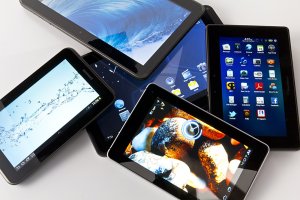
The increase in people using tabelt computers is something that really puzzles me, considering that the majority of people now own a smart phone, as well as a computer or a laptop, and there are very few things that cannot be done on one or both of those devices. However the main reason I have heard for people buying tablets is that it’s “more convinient” to watch films on, play games, or read eBooks etc. The reason this puzzles me is that tablets are fairly expensive, with the cheapest being upwards of £100 pounds, and personally I think that is a lot of money to pay for something slightly more convinient than what you already have access to. I suppose this demonstrates the power and influence of techonology in our lives in a negative fashion, although touch screens have become a standard in most devices which perhaps shows a desire for more physical interactivity in our objects
14. Comic
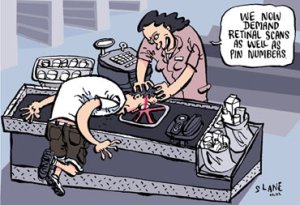 I thought this was an amusing take on the demand for more and more personal information when purchasing items
I thought this was an amusing take on the demand for more and more personal information when purchasing items
15. Tweet leak – Jens Wunderling
This piece is interesting in that it isn’t so much that the artist has made a physical object for people to interact with, but rather takes intangible information in the form of people’s twitter posts from the surrounding area, and gives them a physical form so that it then becomes tangible. The tweets are picked up and printed out in the form of a sticker, so it can then be taken by anybody and not only read, but placed in any context they choose. The author is informed of this, which gives them a sense of loss of control. It is interesting because when you post something on twitter, you are aware that the information is on the internet and it is pretty much permanently available to be read by anybody. But at the same time you assume that it is being read by a very specific audience of people who have chosen to follow you and the idea that it has been taken out of that context and has been left somewhere physically in the world could be very unnerving, and that there is nothing you can do about it unless you go and find it yourself and take it down.
16. Hayes big screen
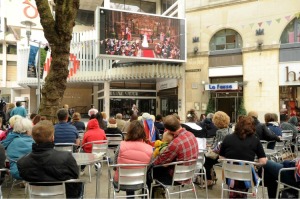
It has always been an interest to me as to why people seem to automatically gather around a screen, no matter what is on it and whether or not is of interest to the people watching. I have often found times where I am sat in a room full of people, but if there is a television screen we will all watch that rather than talk with each other even if it something that none of us enjoy watching. I have noticed this with the big screen in the Hayes in Cardiff. When there is something being displayed on it, for example sports or even something more menial like the news, crowds tend to congregate around it and I find my eye is drawn to it also. I’m not sure what it is about a screen, perhaps it is the constant stream of information and moving images which you don’t necessarily get in day to day life where things can remain much the same for hours on end
17. Oculus Rift

The oculus rift is a product currently in development which has caused much excitement in the gaming community. It is a visor which covers the whole of your vision creating an extremely immersive experience, rather than feeling you are looking at a world through a screen you are placed inside that world and can look around in the same way you would naturally. Demonstrations of the Oculus Rift have been done in conjunction with other products in development such as a form of treadmill that allows you to walk in any direction to control your character, and you can imagine that several years in the future when these technologies are perfected and commonly implemented our experience of gameplay is going to become drastically different. It is almost like something out of a dystopian science fiction novel where people become intergrated with technology so fully and the line between the virtual and real world become so blurred that people find it hard to tell the difference.
18. Mesolithic tools

It occured to me that the word “technology” doesn’t necessarily have to mean it in the sense that it is commonly used meaning powered by electricity. One of the definitions for the word technology in the oxford online dictionary is “Machinery and devices developed from scientific knowledge”, which can mean any form of tool that has some form of application. An example of this is these mesolithic tools, which are very basic forms of tools yet allow us to effect and understand the world better and our created by our knowledge and understanding of how materials and objects work. I think it’s important for me to keep this in mind, rather than getting too tied down with the idea of “technology” in the form of electronics and internet, as I’m not sure how much I can feasibly intergrate that into my outcomes
19. Sun dial
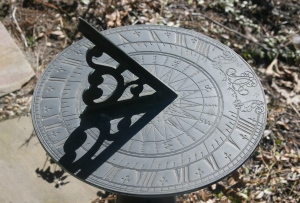
The ability to track the passing of time accurately is one of the most important technologies of our race, and even ancient civilizations had forms of measuring time. Without this, we would have a completely different form of society, as everything we do is so closely linked to the passing of time and how much of it we use. Perhaps this time could become a large factor in my work in reflection of the city
20. A Line made by walking – Richard long
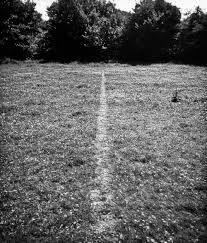
Again looking at basic technology, or perhaps this is even the antithesis and a complete lack of technology. Richard long’s work consists of him effecting the world around him just by the repeated use of his body (for example walking back and forth through a field), or something very simple such as moving rocks into a line. I think the desire to show that we have made an impact on the world is something that we all as humans have, yet we very rarely see it in such a blatant and physical way as Richand Long’s work. Perhaps it is so compelling because you can see the amount of time and effort he has put into a very simple process, and that is a level of dedication and effort that many people including myself also find it hard to do. Whether lack of motivation to do meaningful and productive actions is a new problem brought on by technology, or it is something that has always been present I cannot say, but I know that Long’s dedication is certainly both admirable and breathtaking.
[…] to Jane Edden’s “Post Secrets” instillation in Cardiff (which I talk about as number 8 on my petcha kutcha post), as I want it to be accessible to everybody and easily approachable. I would also ideally like […]
[…] colour rather than something changeable such as Raphael Daden’s painting with light piece (number 6 on my petcha kutcha). I’d like them to be in a public space, but in an area where people are forced to interact […]